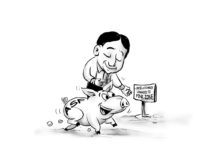
[av_one_full first min_height=” vertical_alignment=” space=” custom_margin=” margin=’0px’ padding=’0px’ border=” border_color=” radius=’0px’ background_color=” src=” background_position=’top left’ background_repeat=’no-repeat’ animation=”]
[av_heading heading=’We are only caretakers’ tag=’h3′ style=’blockquote modern-quote’ size=” subheading_active=’subheading_below’ subheading_size=’15’ padding=’10’ color=” custom_font=” av-medium-font-size-title=” av-small-font-size-title=” av-mini-font-size-title=” av-medium-font-size=” av-small-font-size=” av-mini-font-size=” admin_preview_bg=”]
EDITORIAL
[/av_heading]
[av_textblock size=” font_color=” color=” av-medium-font-size=” av-small-font-size=” av-mini-font-size=” admin_preview_bg=”]
January 20, 2018
[/av_textblock]
[av_textblock size=” font_color=” color=” av-medium-font-size=” av-small-font-size=” av-mini-font-size=” admin_preview_bg=”]
ACCORDING to the Department of Agriculture, about 45 percent of arable land in the Philippines has been moderately to severely eroded, which triggered the movement of subsistence farmers to marginal lands to meet food requirements. Approximately 5.2 million hectares have been severely eroded and 8.5 million hectares have moderately eroded, resulting in a 30-50 percent reduction in soil productivity and water retention capacity.
Our country boasts of rich natural resources and is home to ecosystems and habitats that nurture biologically diverse plants and animals. Further degradation to our lands will undermine our balance with nature, which will drastically affect our food security and other livelihoods of our communities.
The most common type of land degradation in the country is soil erosion, which makes the land less suitable to crop production, or in some cases, total loss of soil productivity. Soil mining, which causes nutrient imbalances and contributes to soil degradation, is also one widespread practice that stagnates rice and corn yields because of excessive use of nitrogen fertilizer. But there are other factors such as rapid urbanization, increasing population, prolonged and frequent occurrence of droughts because of climate change, and the absence or poor implementation of environmental policies.
Soil is a finite, non-renewable natural resource. We depend so much on our lands for food and other resources, but we are not doing our best to prevent them from being degraded due to non-sustainable practices. It is especially important for us, an agricultural country, to be taking care of our land. Land degradation has already affected more than 33 million Filipinos and is likely to contribute to widespread and severe poverty in rural areas.
Among the sustainable land management practices the government can promote are sloping agricultural land technology, organic-based agriculture, farm waste and residue management, wastewater recycling and re-use, and rainwater harvesting. We must capacitate and empower local government units and farmers’ associations in the use and maintenance of soil and water conservation model farms and rainwater harvesting systems.
The resources from our lands and our environment are not infinite. We are only caretakers of the lands that have been providing for us for so long. Protecting and preserving our environment now means that we secure the resources for our future generations.
[/av_textblock]
[/av_one_full]



